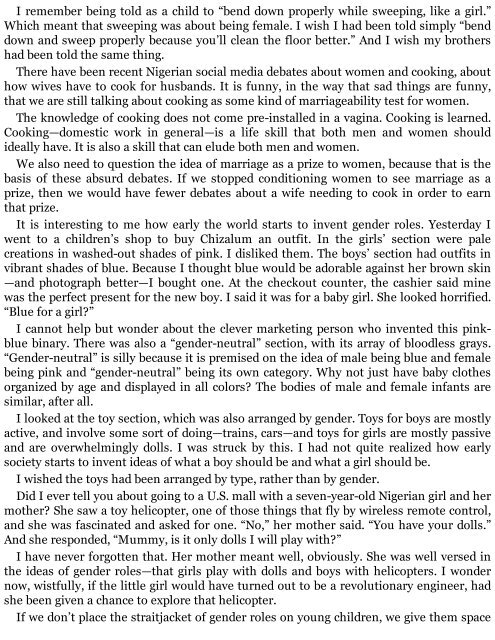You also want an ePaper? Increase the reach of your titles
YUMPU automatically turns print PDFs into web optimized ePapers that Google loves.
I remember being told as a child to “bend down properly while sweeping, like a girl.”<br />
Which meant that sweeping was about being female. I wish I had been told simply “bend<br />
down and sweep properly because you’ll clean the floor better.” And I wish my brothers<br />
had been told the same thing.<br />
There have been recent Nigerian social media debates about women and cooking, about<br />
how wives have to cook for husbands. It is funny, in the way that sad things are funny,<br />
that we are still talking about cooking as some kind of marriageability test for women.<br />
The knowledge of cooking does not come pre-installed in a vagina. Cooking is learned.<br />
Cooking—domestic work in general—is a life skill that both men and women should<br />
ideally have. It is also a skill that can elude both men and women.<br />
We also need to question the idea of marriage as a prize to women, because that is the<br />
basis of these absurd debates. If we stopped conditioning women to see marriage as a<br />
prize, then we would have fewer debates about a wife needing to cook in order to earn<br />
that prize.<br />
It is interesting to me how early the world starts to invent gender roles. Yesterday I<br />
went to a children’s shop to buy Chizalum an outfit. In the girls’ section were pale<br />
creations in washed-out shades of pink. I disliked them. The boys’ section had outfits in<br />
vibrant shades of blue. Because I thought blue would be adorable against her brown skin<br />
—and photograph better—I bought one. At the checkout counter, the cashier said mine<br />
was the perfect present for the new boy. I said it was for a baby girl. She looked horrified.<br />
“Blue for a girl?”<br />
I cannot help but wonder about the clever marketing person who invented this pinkblue<br />
binary. There was also a “gender-neutral” section, with its array of bloodless grays.<br />
“Gender-neutral” is silly because it is premised on the idea of male being blue and female<br />
being pink and “gender-neutral” being its own category. Why not just have baby clothes<br />
organized by age and displayed in all colors? The bodies of male and female infants are<br />
similar, after all.<br />
I looked at the toy section, which was also arranged by gender. Toys for boys are mostly<br />
active, and involve some sort of doing—trains, cars—and toys for girls are mostly passive<br />
and are overwhelmingly dolls. I was struck by this. I had not quite realized how early<br />
society starts to invent ideas of what a boy should be and what a girl should be.<br />
I wished the toys had been arranged by type, rather than by gender.<br />
Did I ever tell you about going to a U.S. mall with a seven-year-old Nigerian girl and her<br />
mother? She saw a toy helicopter, one of those things that fly by wireless remote control,<br />
and she was fascinated and asked for one. “No,” her mother said. “You have your dolls.”<br />
And she responded, “Mummy, is it only dolls I will play with?”<br />
I have never forgotten that. Her mother meant well, obviously. She was well versed in<br />
the ideas of gender roles—that girls play with dolls and boys with helicopters. I wonder<br />
now, wistfully, if the little girl would have turned out to be a revolutionary engineer, had<br />
she been given a chance to explore that helicopter.<br />
If we don’t place the straitjacket of gender roles on young children, we give them space
















